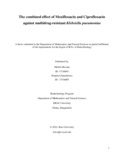| dc.contributor.advisor | Hossain, M. Mahboob | |
| dc.contributor.advisor | Ahmed, Akash | |
| dc.contributor.author | Hossain, Mehrin | |
| dc.contributor.author | Chakrabortty, Deepita | |
| dc.date.accessioned | 2022-05-23T05:19:49Z | |
| dc.date.available | 2022-05-23T05:19:49Z | |
| dc.date.copyright | 2022 | |
| dc.date.issued | 2022 | |
| dc.identifier.other | ID 17136043 | |
| dc.identifier.other | ID 17336007 | |
| dc.identifier.uri | http://hdl.handle.net/10361/16646 | |
| dc.description | This thesis is submitted in partial fulfillment of the requirements for the degree of Bachelor of Science in Biotechnology 2022. | en_US |
| dc.description | Catalogued from PDF version of thesis. | |
| dc.description | Includes bibliographical references (pages 51-54). | |
| dc.description.abstract | People, particularly children under the age of five suffer from pneumonia. One of the supreme pathogens of Pneumonia is Klebsiella pneumoniae which needs to be treated but it’s being burdensome because organisms are getting vastly antimicrobial resistant. Antibiotic resistance is a major problem of the present time; it is currently wreaking havoc on people's lives and livelihoods around the world, and it is expected to grow exponentially in the coming decades if it’s left without treatment. The goal of the research is based on originating an effective way to fight diseases caused by multidrug-resistant Klebsiella pneumoniae in Bangladesh.
From collected bacterial samples, 6 out of 9 were multidrug-resistant. Antibiogram was performed using 19 antibiotics of different classes (Macrolides, Polymyxins, Tetracycline, Nitroimidazole, Cephalosporin, Beta-lactam, Quinolone, Fluoroquinolones, Aminoglycosides, and Penicillin) to differentiate between resistant and sensitive isolates. Then, the research was continued by the screening of several combinations of antibiotics (azithromycin, chloramphenicol, and ciprofloxacin) with moxifloxacin. Individual antibiotics and combinations of screened antibiotics activity were measured using the Minimum Inhibitory Concentration (MIC) determination method. Among the 3 combinations which were screened, moxifloxacin in combination with ciprofloxacin exhibited the best result. Hence, this combination was chosen. This was followed by the Fractional Inhibitory Concentration (FIC) index to provide statistical substantiation of results. The lowest obtained FIC index was 0.5 which indicates a synergistic effect.
The research result showcases that a combination of antibiotics can decrease the needed amount of antibiotics on resistant organisms. These findings could have far-reaching consequences for the future of combination therapy against multidrug-resistant Klebsiella pneumoniae. | en_US |
| dc.description.statementofresponsibility | Mehrin Hossain | |
| dc.description.statementofresponsibility | Deepita Chakrabortty | |
| dc.format.extent | 57 pages | |
| dc.language.iso | en | en_US |
| dc.publisher | Brac University | en_US |
| dc.rights | Brac University theses are protected by copyright. They may be viewed from this source for any purpose, but reproduction or distribution in any format is prohibited without written permission. | |
| dc.subject | Klebsiella pneumoniae | en_US |
| dc.subject | Moxifloxacin | en_US |
| dc.subject | Ciprofloxacin | en_US |
| dc.subject | Multidrug-resistant | en_US |
| dc.subject.lcsh | Bacterial diseases. | |
| dc.subject.lcsh | Pneumonia. | |
| dc.title | The combined effect of Moxifloxacin and Ciprofloxacin against multidrug-resistant Klebsiella pneumoniae | en_US |
| dc.type | Thesis | en_US |
| dc.contributor.department | Department of Mathematics and Natural Sciences, Brac University | |
| dc.description.degree | B. Biotechnology | |

